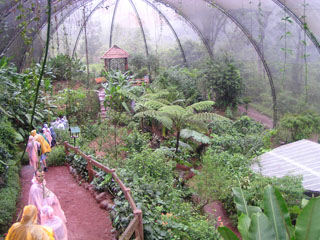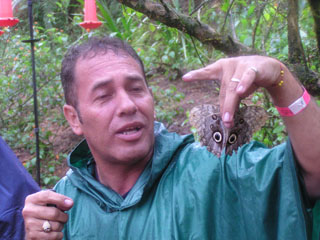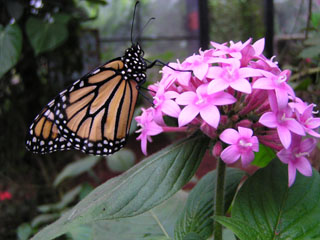The butterflies of La Paz
By Jeff Schult (copyright 2004)
The butterflies at La Paz Waterfall Gardens provided perhaps the most striking visual memory of my trip to Costa Rica, if the view of my teeth in the mirror goes uncounted.
The tour material says the enclosed observatory at La Paz Waterfall Gardens is the largest in the world, which sounds grand, and one might expect it to be big, really big, an Alamodome full of blinding butterfly swarms. But it is not that, at all -- it looks to be just a bubble of woven net or mesh, only a little out of place in the middle of a walk-through rain forest.
It looks flimsy, but probably is not. You can just about see through it, and it lets the rain in. The whole place can be toured in minutes -- the main area seems smaller than half a football field -- but I think that any person with the vaguest sense of wonder would want to spend several hours there. A path wide enough for two or three winds through it, and guests of the butterflies parade through all day, every day. Hummingbirds, and impressive waterfalls, lie ahead on the path; but I was still thinking of butterflies, days later.There are no swarms of butterflies but there are a lot of them jittering about. It you are careful, you can coax one from its rest on a leafy jungle plant by the side of the path to your hand -- slide a finger under it just so. Our guide, Arturo, demonstrated with a big owl butterfly, named for the matched set of eyes on its wings, obviously. It has the wingspan of a smallish bird.
One of every twenty butterflies in the whole world lives inside the boundaries of Costa Rica. I do not know how I can believe this statistic -- a census of butterflies is unimaginable -- but I can believe there are, well, lots. Costa Rica exports butterflies, Arturo tells us. They are prize pollinators of many exotic plants and flowers. I wonder for a moment to ask just how they are exported -- for some reason, my mind conjures up the image of an elite crew of trained lepidopterist-couriers -- but I don't ask. I can look that up later.
I know that many butterflies leave the country in boxes, beautiful and preserved and very dead, as souvenirs, and that is just fine these days with the folks who know about and study rainforests. Butterflies are wild and free, but they are also farm insects, raised and herded. There are plenty -- they are prolific though short-lived -- and there will be plenty as long as the habitats are preserved; and the habitats will be preserved as long as the people who live in the area, and in all of Costa Rica, have a reasonable economic incentive to do so.
Take away the tourists and, as much as Costa Ricans love their land andtheir butterflies, they would be hard-pressed to maintain them. They are hard-pressed, anyway. Dead butterflies in carved boxes may be as gruesome to some as, say, the head of a moose on a lodge wall; but the dead butterflies did their bit, in this world, for species preservation.
My friend Katherine Clark, in Cleveland, argued with me later that no one should be killing butterflies, ever; that the murder of a butterfly diminishes us all. She is right from a poetic viewpoint and maybe even from an ecological one. The eco-tourism proponents could be wrong entirely. But we will assuredly not find out, for sure, for a long time. Either way, I think, the butterflies of Costa Rica are worth seeing, now.
(Back to main article)

Below, Arturo, our guide, showed us how to carefully handle a butterfly; the technique is pretty much what you would expect for any delicate living thing. Place a finger where a butterfly, at rest, will crawl onto your finger -- and let it do so.
Photos by Jeff Schult


Photo by Jeff Schult